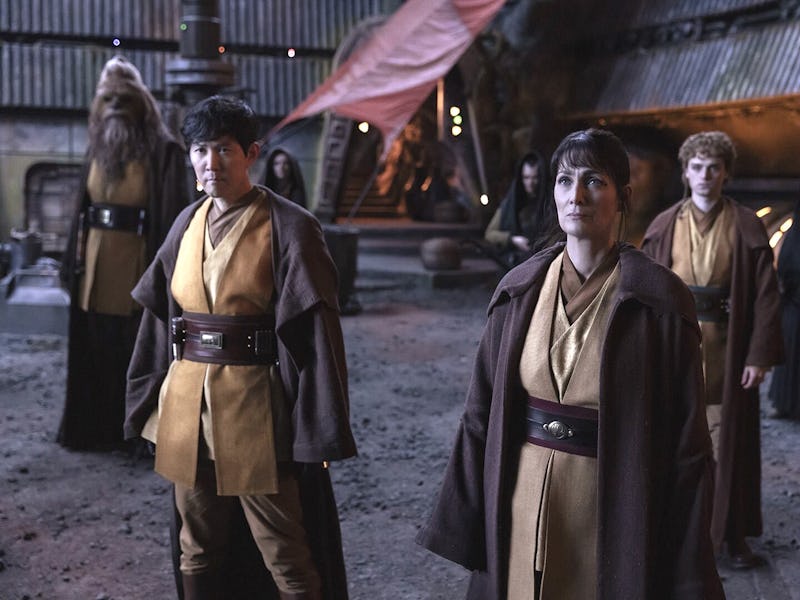The Acolyte Needs to Figure Out What Kind of Show It Wants to Be
Sith doesn’t happen.

In The Acolyte Episode 3, “Destiny,” one question is specifically raised: Are the Jedi good or what? This proactive debate is at the center of the entire show, unpacking the nitty-gritty of what we thought we knew about the Jedi for the past several decades. Just in case you’re confused, Episode 3 makes this dichotomy painfully obvious when Mae screams, “The Jedi are evil!” at young Osha, who counters with the powerful rejoinder, “The Jedi are good!” This attempt to discuss the ethics of the Jedi is interesting, even if it’s clumsy.
This central conversation is obviously compelling, but it also could be the Achilles’ heel of the series. While various trolls pathetically try to dunk on The Acolyte for racist and sexist reasons, diversity is not the show’s problem. Those elements should, of course, be celebrated. But, from a purely structural standpoint, it feels like The Acolyte is trying to do a lot at the same time. The series introduces the High Republic in live action, teases a mysterious Sith villain, tells the story of Mae’s exacting bloody revenge, and drops breadcrumbs for a meandering mystery, which began years in the past. It’s a lot to juggle, and the balls are falling.
Episode 3 has been particularly divisive, although you could scrawl “Star Wars” on a cocktail napkin and start a passionate argument about whether it respects George Lucas’ vision. Still, some fans and critics appreciate the new interpretation of the Force the witches of Brendok provide, while others can’t get past the clunky dialogue and surprisingly cheap look of a show that reportedly cost $180 million.
We can debate how Mae, furious about the prospect of Osha leaving to become a Jedi, managed to set a stone hallway on fire in her abrupt attempt to murder her twin, but let’s take a big-picture look at what The Acolyte has accomplished so far. Episode 1 set the stakes, but most of its runtime was dedicated to proving that Osha was innocent of Master Indara’s murder, which we already knew, and that Master Sol, the Jedi investigating her, strongly suspected. It gave Osha an action-y introduction, but it was a lot of pointless running around to solve a case of mistaken identity with a foregone conclusion.
Almost halfway through The Acolyte, Amandla Stenberg has been given precious little to do.
Episode 2, the strongest so far, saw Mae plot and execute another murder despite the obstacles Osha and the Jedi threw in her path, all while hinting that what split Mae and Osha apart left Master Tobin so guilt-ridden that he willingly drank poison when reminded of it. Then Episode 3 took that subtext and hit caps lock, jumping back 16 years to reveal how the Jedi showed up on Brendok and threatened to remove Osha and Mae from their interpretive dance coven.
In doing so, Episode 3 told us precious little that hadn’t already been implied or outright stated about the twins’ relationship. It also suggested the Jedi were somehow involved in the fire Mae started, but we already knew that too. Episode 3 was torn between fleshing out its characters and bragging about how mysterious the mystery it’s developing is, and the result was children screaming plot points at each other to save time while a bunch of rocks blew up for no apparent reason.
So what kind of show does The Acolyte want to be? A Jedi-police procedural that reveals the hypocrisy at the heart of the High Republic’s protectors? A cat-and-mouse thriller that flips the power dynamics of the original trilogy to make the Sith the plucky underdog struggling against the Jedi? Or a study of once-inseparable twins torn apart by life but desperate to somehow rebuild their relationship? Because with only five episodes left, it can’t be all three, right?
The Acolyte tried to speedrun through Mae and Osha’s childhood, making Episode 3 feel flat.
The Acolyte still has time to correct course, so maybe this criticism is premature. But it’s worth looking at what Andor — the only other Star Wars show to really try something new — accomplished in its first three episodes. Cassian is introduced as a self-interested sleazeball living in a corporate system, a new Star Wars setting with distinct rules. His quest to find his missing sister gets him in over his head and, one murder later, he’s unwillingly sucked into the nascent Rebellion as his crime spirals into a conflict that draws the Empire’s terrifying eye. It’s a propulsive story with clear stakes for everyone involved. There’s even a flashback to Cassian’s youth, but it complements the story instead of strangling it.
About halfway through Episode 1 of The Acolyte, we knew Mae has a grudge against the Jedi, that Master Sol’s drive to resolve the situation suggests the Jedi are right to be blamed for something, and that Osha wants to resolve her love for her sister with her fondness for the Jedi who gave her a life. And now, after three episodes, all that’s changed is that we know a Wookiee Jedi looks cool. Flashing back to characters who haven’t moved from their starting blocks feels like watching people swim through molasses.
The Acolyte’s attempt to do something new with the Star Wars timeline is admirable. But its High Republic setting feels indistinguishable from the prequel era, and its attempt to obfuscate its mysteries has left its underdeveloped characters at a tedious standstill. If it can’t pick a lane soon, the only thing The Acolyte will waste is its proactive potential as the Dark Side clouds its cultural relevance in vagary and confusion.